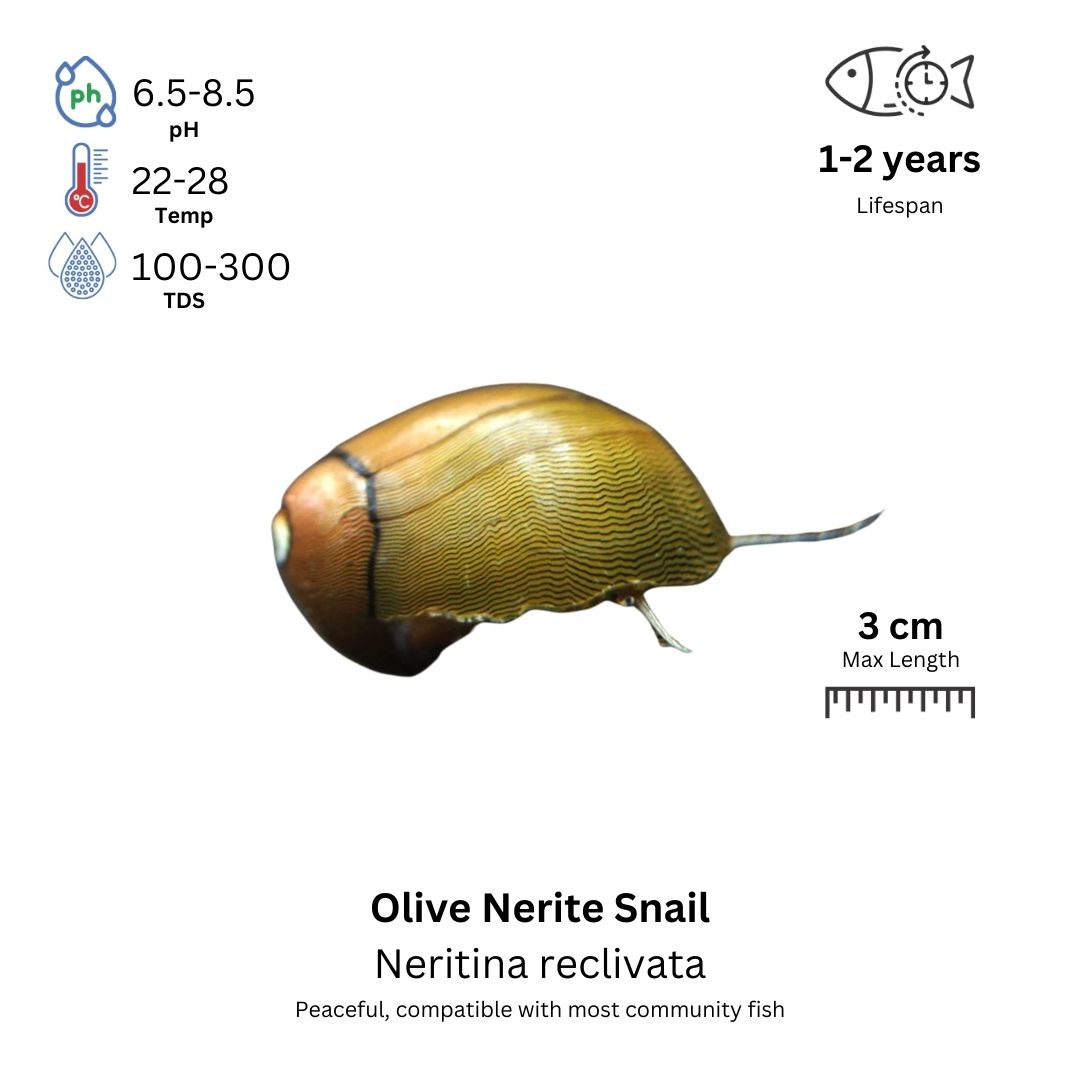Olive Nerite Snail: A Guide for Aquarium Enthusiasts
The Olive Nerite Snail (Vittina usnea) is a popular freshwater snail known for its hardy nature, efficient algae-eating abilities, and smooth olive-green shell. This peaceful invertebrate is an excellent addition to aquariums, helping to maintain water quality by consuming algae without harming live plants.
Characteristics
- Scientific Name: Vittina usnea
- Common Name: Olive Nerite Snail
- Family: Neritidae
- Natural Habitat: Found in coastal rivers, estuaries, and streams in Southeast Asia and Africa.
- Behavior: Peaceful and slow-moving; spends most of its time grazing on surfaces.
- Tank Preferences: Prefers a well-established tank with plenty of biofilm and algae.
- Ideal Water Parameters:
- pH: 7.0 – 8.5
- Hardness: Moderate to hard (6-12 dGH)
- Temperature: 22-28°C (72-82°F)
- Salinity: Can tolerate slightly brackish water, though it thrives in freshwater.
- Care Level: Easy
Origin and Distribution
The Olive Nerite Snail is commonly found in Southeast Asia, Africa, and parts of the Caribbean, inhabiting freshwater and brackish environments. Due to its ability to adapt to varying salinity levels, it is widely distributed across tropical and subtropical regions.
Colors and Markings
- Shell Color: Smooth olive-green to brownish tones with a glossy finish.
- Body Color: Dark gray or black.
- Size: Typically grows to 1-2 cm (0.5 – 1 inch) in diameter.
- Lifespan: Can live 1-2 years with proper care.
Tankmates
- Best Companions:
- Other peaceful invertebrates such as shrimp (Cherry Shrimp, Amano Shrimp).
- Small non-aggressive fish like Tetras, Guppies, and Rasboras.
- Bottom dwellers such as Corydoras and Otocinclus Catfish.
- Avoid:
- Aggressive or predatory fish (e.g., Cichlids, Loaches, Pufferfish) that may harm snails.
- Crabs or aggressive shrimp that may pick at their shells.
Care Requirements
- Tank Size: Minimum 5 gallons, but larger tanks provide better stability.
- Filtration: Requires a well-cycled tank with stable water conditions.
- Water Changes: 20-30% weekly to maintain water quality.
- Lighting: Moderate; helps promote algae growth for natural grazing.
- Substrate & Decor:
- Sand or fine gravel substrate.
- Rocks, driftwood, and aquarium-safe decorations for algae growth.
Diet and Feeding
- Diet Type: Herbivore
- Food Recommendations:
- Primarily feeds on algae, biofilm, and diatoms.
- Supplement with blanched vegetables (zucchini, spinach, cucumber).
- Occasional algae wafers or calcium-rich foods for shell health.
- Feeding Frequency: Typically self-sufficient, but supplements may be needed if algae is scarce.
Reproduction
- Difficulty: Does not reproduce in freshwater.
- Reproduction Requirements:
- Lays small, white egg capsules on hard surfaces (glass, rocks, decorations).
- Eggs will not hatch in freshwater; they require brackish water to develop.
- Population Control: Unlike some snail species, Olive Nerite Snails will not overpopulate a freshwater tank.
Additional Benefits
- Algae Control: One of the best algae-eating snails, helping keep tanks clean.
- Low Maintenance: Requires minimal care and does not damage live plants.
- Non-Invasive: No risk of overbreeding in freshwater environments.
Additional Resources
If you enjoy Olive Nerite Snails, you may also be interested in:
- Zebra Nerite Snail – A striped variety with similar care needs.
- Horned Nerite Snail – A unique Nerite species with small “horns” on its shell.
- Mystery Snail – A larger, plant-safe snail with a variety of colors.




Reviews
There are no reviews yet.